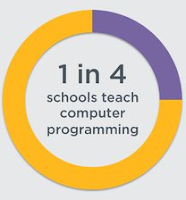
It's Been Awhile
I have to say that this has been the longest absence of blog posts that I have had since I began blogging in 2010. I am currently in my second year at Gilbert Public Schools and my last post was the same month I began my new position, so I have been a bit busy making the transition. However, no more excuses, it is time to get back to sharing, collaborating, and growing on the Interweb.
CS for All
If you have been following Computer Science (CS) for the last couple of years, you are most likely familiar with the various CS initiatives at the federal and state levels. President Obama brought attention on the federal level when he addressed the need for better CS education in his 2016 State of Union Address and followed with his initiative calling for $4 billion in funding and $100 million to districts for teacher training, materials and partnerships. We all know now that $4 billion was not committed too, however, the attention brought to the topic and movement from smaller initiatives have continued to gain momentum and CS initiatives are growing across the country. The current administration under President Trump, in September 2017, issued a memorandum directing the Department of Education to spend $200 million in grants to supporting STEM programs, including CS. Ivanka Trump, who is an adviser to the President, has also been active in supporting STEM education and more specifically for girls. In September, Ivanka, Hadi Partovi (Code.org), and Brad Smith (Microsoft President), visited an elementary school in Virginia to discuss women in STEM fields, Hour of Code, and support for CS in schools with students. This type of awareness and support will need to continue from multiple levels to move CS for all and STEM related education in the right direction.
Why CS
I often hear the question, why is CS important for our students, not all students are going to become coders. True, not all students will be interested in coding, but CS is more than coding and the computational thinking process applies to more than CS. Computational thinking is about the process of solving a problem and potentially using technology for the outcome. The process involves collecting and processing data, looking for patterns, creating the steps to solve the problem and testing the solution for accuracy and efficiency. These are skills that all students can use in a variety of disciplines.
If we take a look at the data around open computer science jobs in the United States, from an economic and innovative perspective, we are in danger of falling behind the curve. According to the Conference Board's Help Wanted Online service, there are around 500,000 CS openings across multiple industries and states. With CS career opportunities being the second highest paid starting salaries according to the National Association of Colleges and Employers, where is the disconnect?
The State of CS
Code.org is a non-profit organization that has been a leader in the vision that every student in every school should have the opportunity to learn computer science. The Hour of Code was launched by Code.org in 2013 and today millions of students in over 180 countries participate in the event during Computer Science Education Week yearly. Code.org also tracks CS policy and implementation across the United States which provides valuable information in a central location for stakeholder access. A deeper dive into the statistics reveals that only 10 states have currently adopted CS standards and in 34 states CS can count towards high school graduation math or science requirements. If we take a look at the current job openings and percentage of graduates in STEM fields with computer science, we will have a lack of workforce to meet the demand and this affects innovation in our country.
CS for AZ
Arizona is seeing momentum towards CS for all in the K-12 school setting and for good reason. There are currently 9,677 open computing jobs in AZ and with only 546 computer science graduates in 2015, the numbers speak for themselves. Of all AZ schools in 2015-16, only 10% offered AP computer science courses and this amounted to the least number of AP tests taken in any other STEM subject area. Of the 438 AP tests that were taken by students, only 23% were female and 68 were underrepresented minorities. Not only are these two demographics underrepresented, but we are missing their perspective, which is something we need to change.
CS for AZ, a non-profit organization, is working with a large group of stakeholders to bring CS to all students in AZ. The organization has brought together a diverse group of educators, AZ government, business leaders, college-level educators and students, working together to provide information and support for CS standards in the state. The positive movement towards their goal can be seen, the Arizona Department of Education has recently opened the call to collect public feedback that will help guide the development of K-12 Computer Science Standards. The working groups that will be formed to develop these standards will represent K-12 educators, higher education, parents, and industry representatives in a collaborative process to ensure the standards represent a diverse population.
Skills
If we want to provide a relevant education for our students we should be supporting them with the skills and exposure necessary to be able to leave the K-12 setting prepared to pursue whatever path they choose. Computer Science skills are not limited to coding but can be used to reinforce such areas as problem-solving, data collection, testing, and analysis, in engaging ways that can apply to a variety of disciplines. Working together we can provide the opportunities for our students to have the skills to solve today's problems and tomorrow's challenges, in whatever capacity they choose.


No comments:
Post a Comment
Note: Only a member of this blog may post a comment.